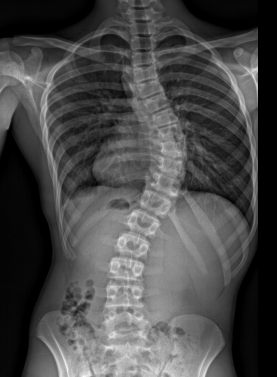Contributed by Kevin Neal, MD, orthopedic surgeon
What is the Apifix device that is used to treat scoliosis?
The Apifix device has a few different names. It can also be called minimally invasive deformity correction (MID-C) or an “internal brace.” The Apifix device is a rod that is used to straighten scoliosis curves without a major spine fusion.
Why do some patients want to avoid spine fusion?
A spine fusion is where the vertebral bodies are stabilized so they can’t move, typically with rods and screws. The joints between the vertebrae bones are removed and bone graft is placed to help the vertebral bodies grow together and become solid. Preventing movement of the spine keeps scoliosis curves from getting worse and keeps the spine straight after it has been corrected. Spine fusion is a great operation for many patients with scoliosis. But some patients want to treat their scoliosis without giving up so much motion in the spine.
Are there alternatives to surgery for scoliosis?
Yes! For very small curves, no treatment is required other than observation, so we can see if the curves will get larger. For moderate-sized curves, we can try braces to keep the curves from getting worse. Braces can prevent curves from getting worse in many cases, but they typically don’t straighten the curves that are already there. If bracing doesn’t work well or if the brace is too hard to wear, the Apifix device might be an option.
Who qualifies for the Apifix device?
To use the Apifix device, patients need to have just a single curve in the spine that is between 30° and 60°. The curve also needs to be quite flexible (bends down to less than 30°) and there shouldn’t be any severely wedged vertebra in the middle of the curve. (Vertebrae usually look like rectangles. If they look like wedges, it can be hard for the Apifix device to correct them well).
How does the Apifix device work?
The Apifix device is attached on one side of the spine in the back using two screws at the top of the curve and one screw at the bottom. The Apifix rod acts like a ratchet and can be lengthened to straighten the curve. Patients can even do exercises after surgery to lengthen the device and provide even more correction. The attachments to the screws are still mobile, so only a little motion is lost.

What’s the recover like from an Apifix surgery?
The short recovery is one of the major benefits of the Apifix device. The incision is smaller than most spine fusions, and since it only involves one side of the spine, it is less traumatic. Also, patients don’t have to wait for bone to grow to fuse the spine, so activities can be allowed sooner. Typically, patients only need to stay overnight one night in the hospital and can return to normal activities after two weeks.
Are there any issues or complications with the Apifix device?
All surgeries carry some risks, for example all surgeries may have a small chance of infection and all spine surgeries have a slight risk of injury to the spinal cord. For the Apifix device specifically, the biggest risk is that they it may be temporary. When we place things in the body that can still move, they may eventually break. Think of bending a paperclip over and over until it breaks. After a very large number of movements the same thing can happen even with large, strong rods. If the Apifix device breaks, it may need to be replaced or converted to a spine fusion. Even if that’s the case, we hope that most patients will have gotten many years of better motion before it happens.



